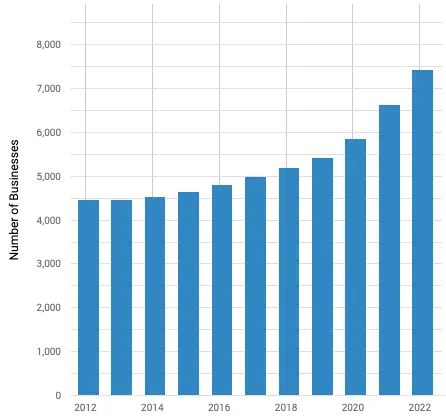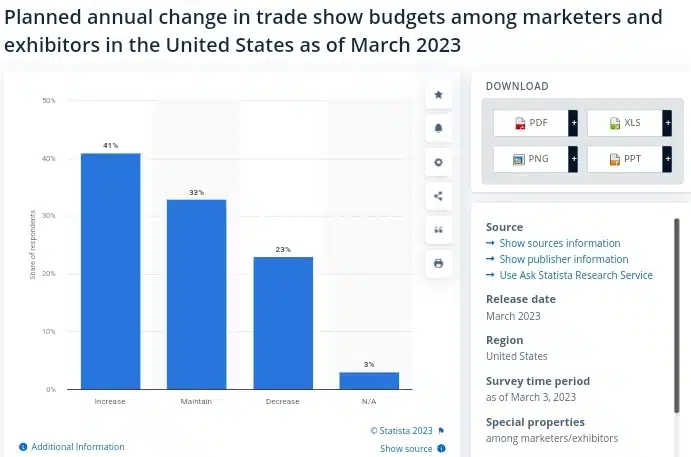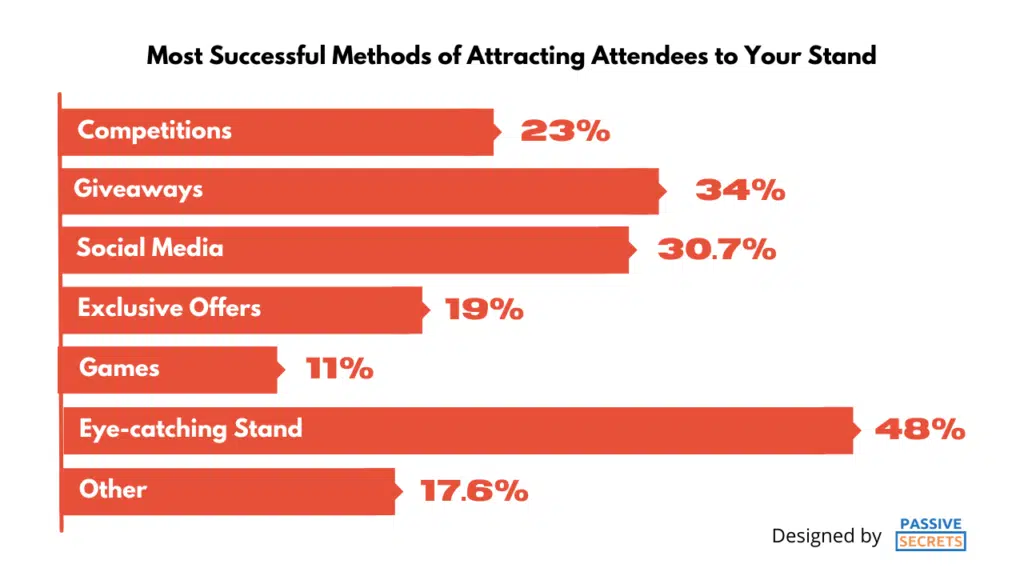
Ah, trade shows! The thrill of the exhibition hall, the hum of networking, and the satisfaction of scoring big leads. But have you ever wondered what really goes on behind the scenes? Let’s dive into some astonishing trade show statistics that will make you rethink your event strategy.
These statistics reveal the ins and outs of the trade show world, from attendee preferences to exhibitor priorities. Understanding these numbers can help you maximize your event experience and make data-driven decisions.
So, let’s explore the world of trade show statistics and discover the secrets to making your next event successful.
Key Trade Show Statistics for Your Business

Trade Show Attendance Statistics And Trends
1. The average attendee at a trade show spends about 5.5 hours there. (source)
2. 48% of exhibitors surveyed say that trade show attendees are attracted to eye-catching stands. (source)
3. 61% of exhibitors say they’re more likely to exhibit again if they’ve had a positive experience at a show before. (source)
4. About 46% of trade show attendees only attend one show per year. (source)
5. 81% of trade show attendees have buying authority. Every business owner’s goal is to keep expanding their customer base, enabling them to maximize profits and sales. Trade fairs offer the visibility needed for this to happen through visitors with buying authority and the potential to become high-value customers. (source)
6. 64% of exhibitors consider the quality of attendees the top factor when deciding whether to participate in a trade show. (source)
7. Most respondents reported that trade shows increased their lead generation (70%) and brand awareness (70%) over the past year. (source)
8. Additionally, 22% of exhibitors found new suppliers, and 12% acquired new skills at trade shows, indicating that these events offer benefits beyond just generating sales. (source)
9. If you have appealing promotional items to deliver, 50% of trade show attendees will likely stop by your exhibit. (source)
10. Trade show booths are focal points in exhibitors’ marketing. Hence, using visually remarkable elements in your trade show booth goes a long way in attracting customers. (source)
11. 92% of trade show attendees primarily go to see the new products that exhibitors feature. (source)
12. 10% of respondents selected ‘other’ advantages of trade shows, primarily highlighting the value of engaging with their customer base, such as obtaining in-person feedback on products and services, which aids in refining their brand strategy. (source)
13. Trade shows generate new leads and benefit staff development, with 68% of respondents noting that working at a trade show improved their sales skills. (source)
General Trade Show Statistics And Trends
14. In 2024, the U.S. B2B trade show market will reach $15.78 billion, exceeding pre-pandemic figures, and is projected to surpass $17.3 billion by 2028. (source)
15. The exhibition market was valued at USD 39.4 billion in 2023 and is expected to grow annually over 7% from 2024 to 2032. (source)
16. 75% of exhibitors face pressure to reduce exhibit costs, with 31% feeling strong pressure from senior leadership. (source)
17. Exhibitors expect tight budgets and additional challenges in the next three years. (source)
18. Exhibitors foresee cost-related challenges in the next three years, with 68% expecting internal budget pressure and 66% anticipating high exhibit costs as a major external challenge. (source)
19. The exhibition market is divided into large enterprises and SMEs. In 2023, large enterprises held about 73% of the market share. (source)
20. The event and exhibition industry is projected to reach $50 billion in revenue by 2025, growing at an annual rate of nearly 4%. (source)
21. 75% of US marketers and exhibitors are confident that their trade shows will outperform 2022 results, with 16% extremely confident and 9% uncertain. (source)
22. In 2022, the meeting, convention, and event planning market in the U.S. employed about 132,000 people, with around 4,700 being self-employed. By 2032, the number of self-employed workers in this sector will grow to approximately 7,300. (source)
23. In 2023, North America was the leading region in the exhibition market, holding about 35% of the market share. (source)
24. Due to exhibit costs, 82% of exhibitors plan to reduce in-person trade shows. Also, 75% of exhibitors face cost-cutting pressure, and 94% expect changes to their exhibit programs in the next three years. (source)
25. Almost all (98%) exhibit leaders have either the final say or significant input in deciding whether to participate in trade shows. (source)
26. About 95% of regular exhibitors prefer in-person events, such as trade show events, to virtual events. (source)
27. 58% of regular exhibitors reported that their team gained extra product knowledge from these events. (source)
28. The top factors affecting global event-related business include changing customer expectations, which ranked highest and was noted by nearly 70% of respondents. (source)
29. 95% of attendees believe in-person B2B expos offer unique benefits that can’t be replicated through other channels. (source)
30. 65% of businesses say in-person trade shows were an invaluable part of their marketing strategy. (source)
31. 88% of businesses exhibit at trade shows to raise awareness for their brand or new products and services. (source)
32. 72% of exhibitors participate in trade shows to get new leads and potential buyers. (source)
33. 83% of marketers will likely attend in-person events and trade shows. (source)
34. In 2024, the planned average number of national and international events dropped to 12.5 and 5.1, respectively. (source)
35. In 2024, about 42% of U.S. event marketers reported their exhibit-marketing budgets stayed the same as the previous year. Just over one-third (34%) saw an increase, while 19% experienced a decrease. (source)

36. The number of U.S business exhibitors in the trade show industry has grown by an average of 3.8% per year in the last five years (2018-2023) (source)
37. The biggest challenge with exhibition venues was the cost of floor space and utilities, which 72% of respondents identified as a problem. (source)
38. As of 2023, the total number of businesses in the U.S. in the trade show industry was 44,327. (source)
39. In the U.S. Trade Show and Conference Planning industry, the highest costs as a percentage of revenue are Purchases (36.6%), Wages (25.3%), and Rent & Utilities (2.1%). (source)
40. 81% of trade show exhibitors use emails to follow up on their trade show leads. (source)
41. A late-2023 global survey found that 45% of meeting professionals increased their social media use after COVID-19, while nearly 40% had always been active on social media. (source)
42. A survey of conventions and meetings industry professionals found that 8% reported fewer than 200 attendees at their largest event. (source)
43. In 2019, U.S. convention and meetings industry professionals reported that, on average, 46% of revenue from large events came from registration, and 21% came from exhibit sales. (source)
44. As of late 2023, the largest exhibition hall was the China Import & Export Fair Complex at 504,000 square meters, followed by Shanghai’s NECC at 470,000 square meters and Shenzhen World Exhibition & Convention Centre at 400,000 square meters. (source)
45. In-person events have made a strong comeback, growing by 40.3% in the first five months of 2024 compared to the same period in the previous year. (source)
46. The average trade show exhibitor spends 40% of their budget on their exhibit, including 12% for designing and 28% for renting booth space (12 per). (source)
47. Social media campaigns effectively promote organizations’ business before, during, and after a trade show event. (source)
48. 85% of business executives have identified trade shows and events as essential for their company’s success. (source)
49. Verified Market Research reports that the global events industry is expected to experience significant growth, increasing from $886.99 billion in 2020 to $2,194.40 billion by 2028, with a CAGR of 13.48% from 2021 to 2028. (source)
50. 90% of event organizers intend to invest in virtual events, while 95% of event marketers anticipate a resurgence of in-person events. (source)
51. Meeting a prospect face-to-face at a trade show event costs about $142 per meeting. This is less than the $250 it costs to meet a prospect at their office. (source)
52. In the U.S., there are 7,426 businesses involved in trade show and conference planning. (source)
53. The total number of international trade show events amounts to about 20,000 per year. Therefore, the U.S. accounts for about 40% of annual trade shows. (source)
54. The next biggest concern with exhibiting at a trade show was transportation to the venue, with 26% of respondents citing it as a problem. (source)
55. 64% of surveyed exhibitors stated that the quality of attendees was the most crucial factor in deciding to exhibit at a trade show. This was followed by Cost (54%), trade show industry (40%), and geographical location (38%). (source)
56. 76% of exhibitors report that their event is integrated with their other marketing campaigns. (source)
57. In early 2024, 20% of exhibitors cited the home market economy as their biggest challenge, while 17% highlighted global economic developments. (source)

B2B Trade Show Marketing Statistics And Trends
B2B marketers benefit most from trade show events, especially those in the technology industry.
Through in-person meetings and networking, these B2B marketers or companies can generate leads that will eventually become paying customers.
58. In early 2023, 20% of U.S. marketers planned to increase spending on VIP events, 18% on user conferences, and none on virtual events. (source)
59. 67% of exhibitors see trade shows as an effective sales generator. (source)
60. 70% of exhibitors say their leadership values trade shows as a key marketing tool. (source)
61. In early 2023, U.S. marketers and exhibitors planned to spend nearly $1.4 million on trade shows, up 70% from $805 million in 2022 and 9% higher than the 2019 pre-pandemic level. (source)
62. A 2024 survey of US event marketers found that 37% plan to increase their trade show social media budget, while 60% will maintain it. Also, 30% aim to boost their event content creation spending, while 60% will keep it the same. (source)
Latest Virtual Trade Show Statistics
63. In 2022, 40% of marketing events were expected to be virtual, up from 35% in 2020. Hybrid events also grew, with 33% of trade shows in 2021 featuring both in-person and virtual elements. (source)
64. The global virtual events market was valued at USD 78.53 billion in 2023 and is projected to grow at an 18.8% CAGR through 2030. (source)
65. In 2019, the virtual tradeshow conference software market was valued at $77.98 billion, with a projected growth rate of 23.2% annually from 2020 to 2027. (source)
The Future Trade Show Industry
Sustainability Trends
The importance of embracing sustainability and going green will continue to grow. Exhibitors are expected to provide clients with sustainable options for exhibition booths and related services. It’s time to take concrete steps towards sustainability.
Using less nylon materials, reducing energy consumption using LED screens, and switching from paper to digital media can significantly impact.
Additionally, recycling materials locally can have a substantial effect.
You can also create a digital information pack that outlines your sustainability efforts. This pack can include practical tips on reducing your carbon footprint and details on how exhibition materials are reused or recycled.
Generative AI
Artificial intelligence is transforming the trade show industry. For example, AI-powered tools organize exhibitions, enhancing the overall experience. Robots and chatbots facilitate communication and navigation, helping visitors find their desired stands.
Additionally, AI-driven matchmaking streamlines connections, directing attendees to relevant exhibitors based on their interests and profiles, saving time and increasing efficiency.
More Networking
Trade shows offer more than just product showcases; they also provide valuable networking opportunities. In 2024, expect organizers to enhance networking experiences, both in-person and virtual, using features like AI-powered matchmaking, virtual lounges, and targeted meetups.
These tools help attendees connect with relevant peers, potential partners, and industry experts, fostering meaningful relationships and business growth.
While traditional trade show networking can be hit-or-miss, AI-powered matchmaking solves this issue by streamlining connections and making interactions more personalized and efficient.
What’s Ahead For Your Next Show With These Trade Show Statistics
The trade show statistics reveal that trade shows are a great way to grow your business and meet people in your industry. The industry is growing fast and will be worth $2,194.40 billion by 2028.
Knowing what works is important to get the most out of trade shows. This includes having the right attendees, using technology to connect people, and making networking easy. By understanding these things, you can make trade shows work for you and help your business succeed.
FAQs

Other Similar Posts You Should Know:
- B2B Sales Statistics: Latest Insights and Trends
- 50+ Essential Traditional Marketing Statistics & Trends
- 60+ QR Code Statistics, Usage, Forecasts & Trends
- 90+ Useful Marketing Jobs Statistics & Facts (Latest Report)
- Sales Enablement Statistics: Data You Need to Drive Sales Growth
- In-store vs Online Shopping Statistics And Analysis
- Social Media Addiction Statistics
- Latest In-Game Advertising Statistics
- From Passion to Profit: 120+ Creator Economy Statistics
- 80+ Big Marketing Software Statistics
- 45 Interesting Healthcare Marketing Statistics & Trends
- Print Marketing Statistics: Ad Spending, Market Size, & More
- Key Short-Form Video Statistics and Trends You Should Know
- 49 Interesting Emotional Marketing Statistics
- 90 Amazing Millionaire Statistics
- 70+ Top Law Firm Marketing Statistics & NEW Trends
- Millennials on Social Media Statistics
- 23 Most Interesting First Impression Statistics To Know
- 60+ Interesting Storytelling Statistics, Facts & Huge Trends
- Amazon Book Sales Statistics: Intriguing Numbers and Facts
- 61+ Useful Podcast Advertising Statistics And Trends
- 50+ Useful Call Center Statistics And Trends
- 50 Crucial Amazon Advertising Statistics & Trends
- 65+ Must-Know Pay-Per-Click Statistics
- 40+ Interesting Omnichannel Marketing Statistics & Trends
- Multi-Level And Network Marketing Statistics, Facts & Trends
- Virtual Event Statistics & Benchmarks For Marketers & Organizers
- 55 Interesting Direct Mail Marketing Statistics and Trends
- B2B Lead Generation Statistics, Facts, Trends, Benchmarks, & Market Size
- 100+ Top Digital Marketing Vs. Traditional Marketing Stats
- 110+ Important Social Media Advertising Statistics & Trends
- 50 Interesting Organic Vs Paid Search Statistics To Know
- 41+ MOST Important Copywriting Statistics To Know
- 80+ Useful Sales Funnel Statistics & Conversion Rates
- 40+ Latest Multi-Channel Marketing Statistics & Huge Trends

